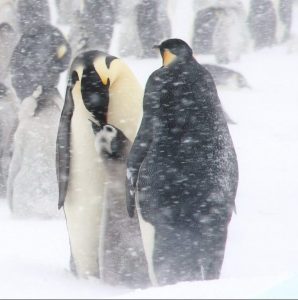Emperor Penguin Field Expedition 2019
Hidden Lives of Emperor Penguins
Background
Despite being the first emperor penguin colony discovered in 1902 during Scott’s Discovery Expedition(1901–1904) little is known about that at-sea behavior of emperor penguins from Cape Crozier. The first science expedition to study them was in 1911, when a small group from Scott’s Terra Nova Expedition team made the perilous journey to the colony in the winter to collect eggs. Since this early study, most research at the Crozier colony has involved counting the birds to monitor the population. This fall we will head to Cape Crozier to study the foraging ecology of one of the southernmost emperor penguin colonies. We hope that you will follow along on our adventure as we prepare for the field work, travel to Antarctica to study the birds, and analyze the data. We look forward to sharing with you new discoveries about the ecology of the emperors of the ice.
This is an internationally collaborative project with logistic support provided by Antarctica New Zealand and primary funding provided to NIWA as part of the project “Ross Sea Research and Monitoring Programme: is the world’s largest MPA effective” (New Zealand Ministry of Business, Innovation and Employment: 2017-2022). Additional funding has been awarded to Birgitte McDonald by the National Geographic Society (Grant # NGS-50069R-18) and SeaWorld Conservation Fund.
Project Objectives
As abundant year-round predators, emperor penguins have a significant top down effect on prey in the Antarctic Ecosystem. It is vital to obtain information on their foraging ecology to understand their role in the ecosystem and how this may change with environmental change. Our collaborative project will investigate the foraging ecology and habitat use of Ross Sea emperor penguins during late chick rearing, an energetically challenging phase of the life cycle when parents must meet the energetic demands of their rapidly growing chicks. Specifically, we will use a combination of video cameras, fine-scale movement data loggers, and stable isotope analysis to: 1) Determine the activity budget of emperor penguins and estimate energy expenditure during a foraging trip, 2) Identify key prey of emperor penguins and identify stereotypical behaviors associated with foraging on different prey types. 3)Combine the energy estimations with the diet and foraging success data, to assess if emperor penguins are foraging optimally, and 4) Integrate penguin behavioral data with environmental data to identify which environmental features are indicative of habitat preference and associated with energy gain. This study fills important knowledge gaps on energy balance, diet, foraging strategy, and habitat use of emperor penguins.









